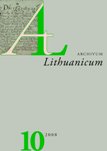Dėl asmenvardžių su priesaga -(i)ūnas paplitimo XVII amžiuje
On the distribution of personal names with the suffix -(i)ūnas in the seventeenth century
Author(s): Vitalija MaciejauskienėSubject(s): Theoretical Linguistics, Applied Linguistics, Historical Linguistics, Sociolinguistics, Baltic Languages
Published by: Lietuvių Kalbos Institutas
Keywords: Lithuanian language; suffix; surnames; Lankeliškes district;
Summary/Abstract: The object of this article is to supplement the seventeenth century data on the distribution of personal names with the patronymic suffix ‑(i)ūnas. Such a possibility emerged after the surnames in one church source were investigated—the book of the wedding records of Lankeliškės parish in 1617–1692. After describing the source and explaining the principles of personal name selection (an attempt to make the analysis and especially the statistical treatment as precise as possible) I note that this article covers around 2800 historical personal names. They name one party in wedding records of the source—the grooms. The personal names under investigation in regard to word formation do not stand out in the context of the seventeenth century surnames. Patronymics formed mostly with the Lithuanian patronymic suffixes predominate. The personal names under investigation were divided into three groups: (1) derivatives of Lithuanian patronymic suffixes, (2) names with Slavic patronymic or ‑sk‑ type suffixes, and (3) names without the suffixes mentioned in the first two groups. I conclude that the personal names of the first group constitute about 72.46%, the second group about 9.9%, and the third one about 17.63% of all personal names. Personal names of the first group (derivatives with Lithuanian patronymic suffixes) have five Lithuanian patronymic suffixes. They can be listed in the following order according to productivity: ‑aitis (its derivatives constitute about 49.43% of all analyzed personal names), ‑(i)ūnas (about 14.93%), ‑(i)onis (about 5.92%), ‑ynas (about 1.98%), and ‑ėnas (0.17%). The abundance of patronymics and frequency of Lithuanian suffixes have helped to trace a great number of derivatives with the suffix ‑(i)ūnas in this part of Lithuania—in today’s Vilkaviškis district.
Journal: Archivum Lithuanicum
- Issue Year: 2008
- Issue No: 10
- Page Range: 137-156
- Page Count: 20
- Language: Lithuanian

